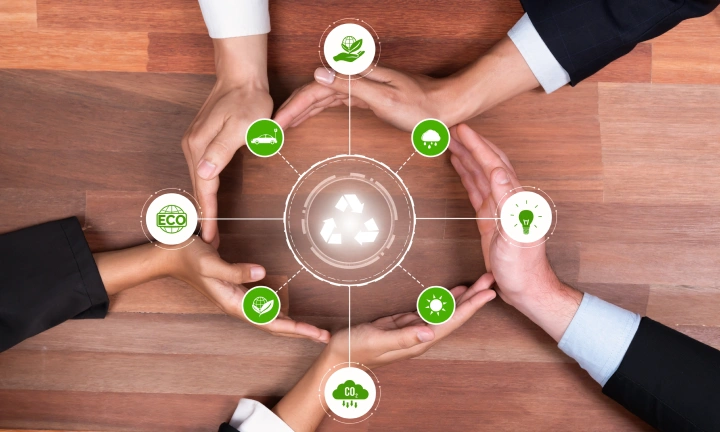All companies, be it in manufacturing, services, distribution, or construction, are looking for a comprehensive approach towards sustainable IT.
Most of the customers we talk to ask if it is even possible to have this Information Technology as a catalyst; leave alone a participant in attaining sustainability. The answer is, it depends. It depends on how you are looking at it. Are you looking at it as a Stand-alone perspective and solution approach or are you looking at it from a holistic perspective wherein all resources are considered including human resources, power resources, building infrastructure, and IT infrastructure. Ultimately the goal is that we move towards a sustainable model that is aligned to the national and global commitment of sustainability and zero carbon emissions. This is the reason why the approach must be extremely comprehensive and inclusive.
If you look at the following diagram you will see that there are a lot of things that have to be considered:
Hardware
Hey are you purchasing the right kind of hardware? Are you looking at a long term perspective or short term perspective, when it comes to hardware purchase because if you do not buy systems that have, for example, the energy-saving capabilities inbuilt, you are going to end up spending more energy than is actually needed? And as the system gets older energy consumption gets higher.
Software
Nowadays even software has power-saving capabilities and if the hardware and software are properly synced then the power consumption footprint can drastically be reduced. This also has to be taken into consideration while purchasing. There is even specialized software that do this very efficiently.
Networks
Whether it’s the local network or a wide area network, each decision has an impact on power consumption and sustainability. Take for example the need for lying a cable versus having a WiFi connection. The need for redundancy and the need for safety all contribute towards decisions that will impact sustainability. Build a network that is modular and takes into account what is the possibility of increased network traffic. Also, consider whether a physical router is appropriate or even a software router would do.
Maintenance
Your approach towards maintenance should also consider the approach of having an in-house team versus an outsourced team. Better still, if having an IoT-based approach is better should also be seriously considered. In this approach the information is directly transmitted from the machinery, the building or the target device to a dashboard that utilizes tools like artificial intelligence and machine learning to give you a predictive analysis on when is the likelihood of a system failure and what prevention should be taken so that this does not happen. As you can see IT can play a part here.
Storage
Your approach toward storage and the media you consume for storage also has an impact on sustainability. Do you need to keep hard drives as backups or do you need to have a cloud-based backup solution? Data stored in physical devices and kept in storage containers are forgotten and soon the data it stores is useless unless it is utilized for getting insights in making quick business decisions. At the same time, you have to keep track of where you have stored your data, on which device type or media type you have stored it and how long will you keep it in that physical device before you discard it. Looking at all these complications, everyone is moving to the cloud; as you may have noticed.
Disposal
At any given time, you are purchasing hardware or other new items, without having a proper policy or exit strategy for items that have become obsolete or are no longer useful in the current state and format they are in. Do not make this common mistake. You should be able to have a clearly defined recycling policy on the basis of which you make sure your disposal is not harmful to the environment. There are many companies that specialize in doing this task specifically.
Energy Source
Now that you have got the hang of the other components, you should look at increasing the percentage of power consumption going off the grid on a regular basis each year, and supported by renewable energy sources like solar, wind, wave, or any other source that is now easily available to deploy. You can do this as a test in a plant, or a large warehouse or a datacentre to begin with, and then expand as you go along.
Resource Ecosystem
Once you have done this exercise in all the other areas mentioned above, you can create an ecosystem wherein corporates and organizations as a community share the resources of each other to actually compensate for the unutilised power or infrastructure that may be of the neighborhood (irrespective of which industry they are in) or create a sort of cooperative that would ensure everyone is not only up and running faster but also saving money by sharing resources!
Conclusion
Yes, Information Technology has a major role to play if a company is planning to or has already declared that they will in the near future become a zero-carbon emitting and sustainable entity! But you cannot see it in a silo, you have to look at the big picture and make IT an integral part of your strategy to achieve that goal.

